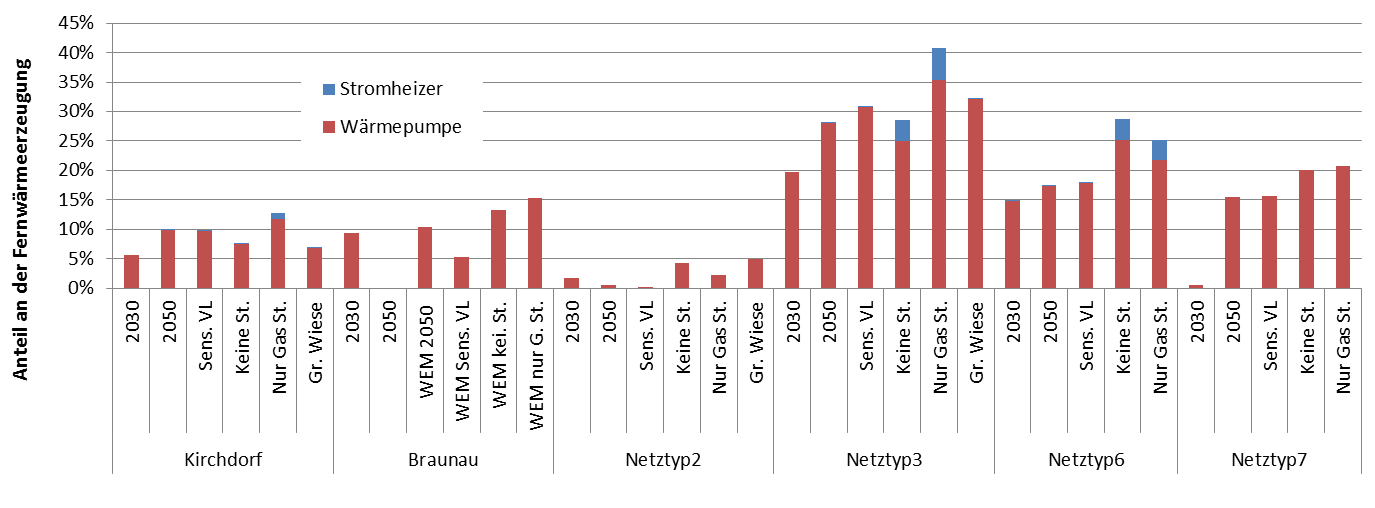P2H-Pot - Potentials, economic feasibility and system solutions for Power-to-Heat
Short Description
Status
completed
Summary
Starting point / motivation
The reduction of CO2-emissions in the energy sector also requires a reduction of CO2-emissions in district heating supply. Additionally, the need for flexibility of the electricity demand increases with the growing share of volatile renewable energy. Thus, the use of electricity in the heating sector, combined with heat storage in times when cheap renewable surplus electricity is available (Power-to-Heat = P2H), promises great potential to reduce the CO2-emissions in district heating from an economic point of view. At the same time, flexibility can potentially be provided to the electricity demand.
Contents and Objectives
The objective of the project was to define technical and economic potentials of innovative P2H system solutions in urban regions till 2030 and 2050 and to determine the required framework conditions.
Methods
Within the project, Austrian district heating networks and selected characteristic networks for detailed modelling were classified. Model-based scenarios for space heating and domestic hot water were developed applying the existing model Invert/EE-Lab and the resulting district heating expansion potential and district heating demand were simulated. Furthermore, changes in the heat load profiles were analysed and thermodynamic simulations of innovative P2H solutions were conducted. All these inputs were used for the energy system model HiREPS to calculate optimized portfolios for the district heating supply of selected networks for the years 2030 and 2050. This allows the identification of the potential future role of P2H.
Heat pumps are an economic viable option in district heating networks already using geothermal energy under the condition, that the geothermal power or supply temperature are not sufficient. Even though a positive impact on the economy of P2H due to the reduction of taxes and fees for electricity can be seen, the results show that other conditions in the district heating network are more relevant. Especially the power of available cheap excess heat sources and the competition with potentials of direct usable excess heat, geothermal power and heat from waste incineration CHP plants. The taxes, network charges and fees are particularly relevant for the economic share of direct electric heating in district heating. Assuming current taxes and charges, electric heaters are not suitable for heat supply in the analyzed scenarios up to 2050 from an economic point of view. The simulation of the potential of P2H for balancing power was out of scope in this study. Present experiences show that electric boilers can be economic for providing balancing power. Heat pumps contribute to a reduction of the CO2-emissions in the district heating supply and to a reduction of fuel and resource consumption. Nevertheless, essential core for reduction of the CO2-emissions in the district heating sector is the efficiency increase in the building sector. In winter the heat pumps are mainly used for base load operation, whereas in transition periods and summer (April to September) they provide flexibility to the electricity demand. According to a recent PhD thesis (Rab, 2017) heat pumps contribute as part of a district heat generation portfolio to the risk hedging against long term price risks.
Results and Conclusions
The simulation results for the scenarios show the potential of major market shares for large heat pumps in the district heating supply assuming a high share of renewables and low CO2 emissions. The share of heat pumps in the district heating supply manly varies between 10 and 30 % in 2050, depending on the scenario. For most of the considered district heating networks, heat pumps are already economic viable in 2030. The considered sources of anergy in this study are flue gas condensation, low-temperature excess heat and geothermal energy. The results show, that heat pumps in combination with flue gas condensation are economic promising options for larger biomass-CHPs and biomass heat plants. Also a high share of CCGT allows heat pumps to cover up to 35 % of the supply. The limiting factor in all above mentioned cases is the amount of available anergy as heat source. For other analysed district heating networks (Kirchdorf, Braunau, district heat network type 2 – i.e. a large city with waste incineration, CCGT CHP, biomass CHP, industrial excess heat and additional excess heat potential) the demand supplied by heat pumps is limited by competing heat supply options: available excess heat potentials, geothermal energy or waste incineration CHP.
Project Partners
Project management
Vienna University of Technology
Institute of Energy Systems and Electrical Drives
- Dr. Lukas Kranzl
Project or cooperation partners
- Energie AG OÖ Wärme GmbH
- ECOP Technologies GmbH
- aqotec GmbH
- ENERGIANALYSE.DK
- e-think
Contact Address
Vienna University of Technology
Institute of Energy Systems and Electrical Drives
Gusshausstrasse 25-29 / 370-3
A-1040 Wien
Tel.: +43 (1) 58801-370351
Fax: +43 (1) 58801-370397
E-Mail: kranzl@eeg.tuwien.ac.at
Web: www.eeg.tuwien.ac.at

